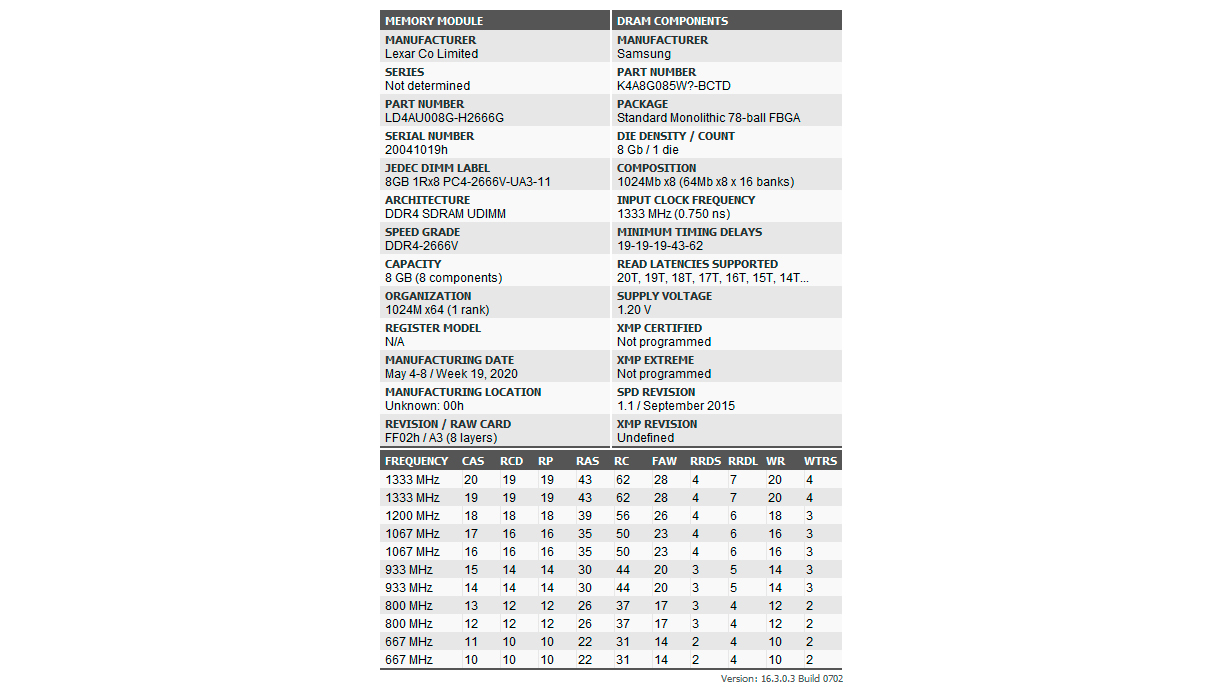Tom's Hardware Verdict
Lexar's DDR4-2666 memory kit isn't the worse that we've seen, but there is definately a lot of room for improvement.
Pros
- +
Some overclocking headroom
Cons
- -
Too pricey
- -
Slow performance
- -
Sloppy timings for DDR4-2666
- -
Only available as single modules
Why you can trust Tom's Hardware
It's always hard to get into a new market, especially one where there's tough competition in every corner. Lexar took a leap of faith, and the brand became one of the newest players to venture into the memory game. The storage expert, now turned memory vendor, has launched an extensive DRAM portfolio consisting of both UDIMM and SO-DIMM solutions. Lexar's memory products currently lack a clear identity. For now, the company is just marketing its kits as UDIMM desktop memory or SO-DIMM laptop memory. This is probably just a stepping stone for Lexar before the company delivers more exotic options in the future.
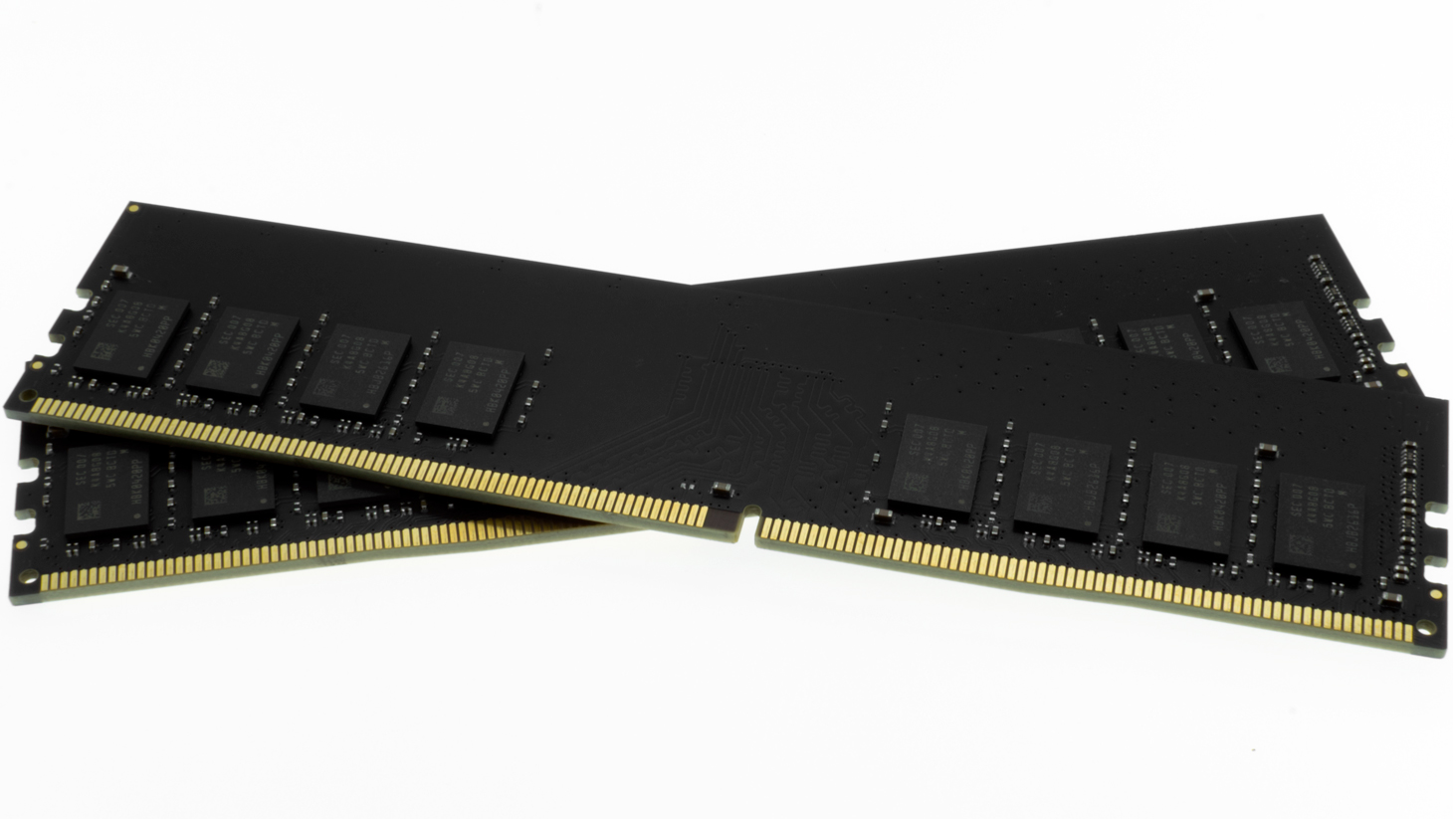
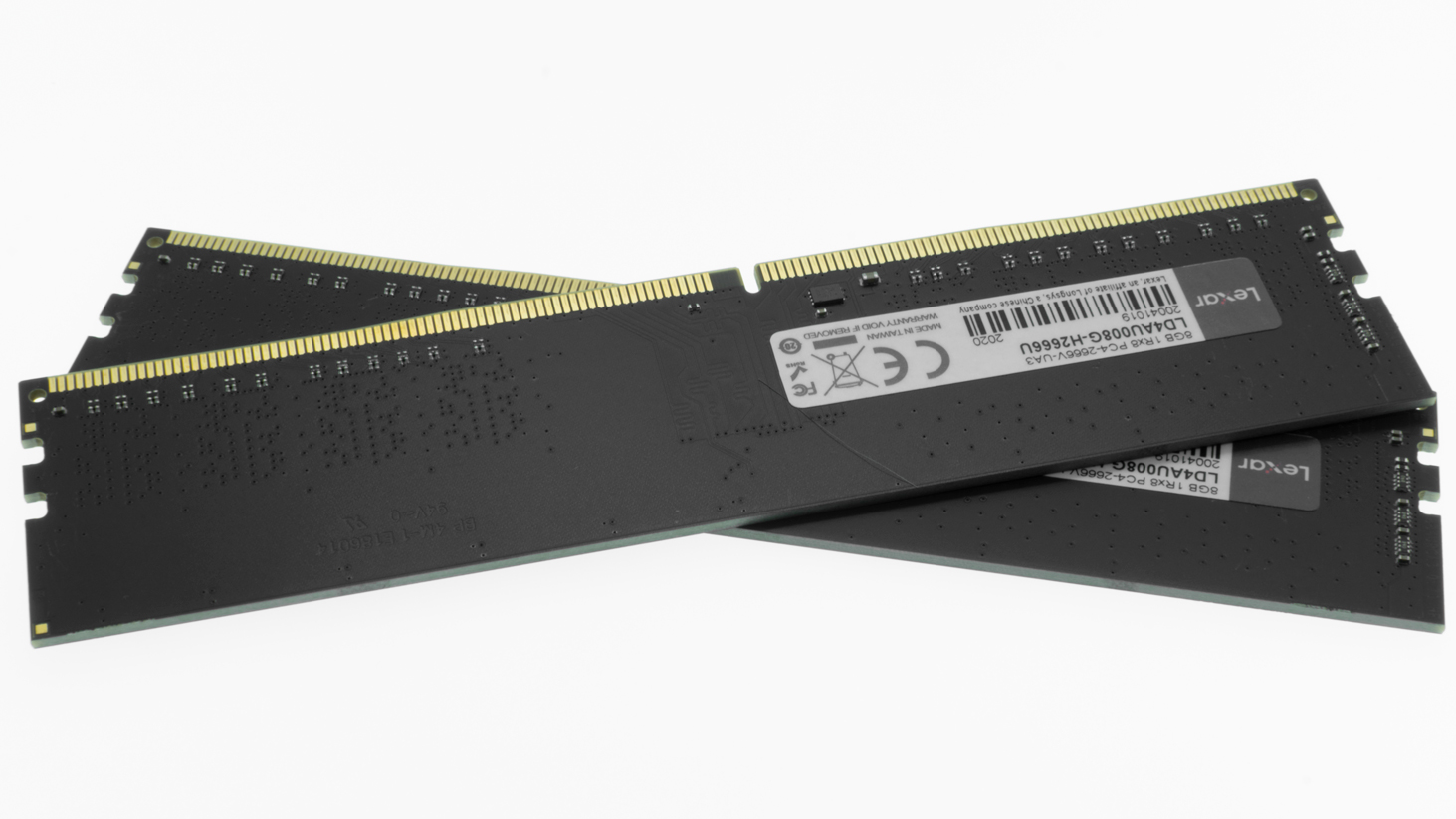

Lexar's memory modules are as basic as they come. The memory modules lack heat spreaders and flashy RGB lighting. What you see is essentially what you get - a simple, black PCB with integrated circuits (ICs). Not that it matters given the undressed design, but the memory modules measure 31.26mm (1.23 inches), so you won't ever have to worry about not having enough room under your CPU cooler for these memory modules.
The lack of a heat spreader does allow us to snoop into the ICs easily. We can't speak for the other frequencies, but the DDR4-2666 memory modules use Samsung K4A8G085WC-BCTD ICs, also known around the block as C-die. Lexar only sells its DDR4 memory as single modules, which can be inconvenient for buyers that need higher densities; we don't recommend mixing and matching memory modules even if they are from the same brand and series.
Assuming that Lexar programmed the correct values into the SPD, the DDR4-2666 memory modules are fabricated with an eight-layer PCB. They feature a single-rank design and, as mentioned previously, employ Samsung C-die ICs.
Lexar's memory modules are binned at DDR4-2666 and don't come with any XMP profiles. By default, the memory modules run with 19-19-19-43 timings and a 1.2V DRAM voltage. For more on timings and frequency considerations, see our PC Memory 101 feature, as well as our How to Shop for RAM feature.
Comparison Hardware
| Memory Kit | Part Number | Capacity | Data Rate | Primary Timings | Voltage | Warranty |
|---|---|---|---|---|---|---|
| G.Skill Trident Z Neo | F4-3600C14D-16GTZNB | 2 x 8GB | DDR4-3600 (XMP) | 14-15-15-35 (2T) | 1.45 Volts | Lifetime |
| Adata XPG Spectrix D60G | AX4U360038G14C-DT60 | 2 x 8GB | DDR4-3600 (XMP) | 14-15-15-35 (2T) | 1.45 Volts | Lifetime |
| Team Group T-Force Xtreem ARGB | TF10D416G3600HC14CDC01 | 2 x 8GB | DDR4-3600 (XMP) | 14-15-15-35 (2T) | 1.45 Volts | Lifetime |
| Adata XPG Spectrix D50 | AX4U360038G18A-DT50 | 2 x 8GB | DDR4-3600 (XMP) | 18-20-20-42 (2T) | 1.35 Volts | Lifetime |
| HP V8 | 7EH92AA#ABM x 2 | 2 x 8GB | DDR4-3600 (XMP) | 18-20-20-40 (2T) | 1.35 Volts | 5 Years |
| Lexar DDR4-2666 | LD4AU008G-R2666U x 2 | 2 x 8GB | DDR4-2666 | 19-19-19-43 (2T) | 1.20 Volts | Lifetime |
Our Intel test system consists of an Intel Core i7-10700K and MSI MEG Z490 Ace with the 7C71v11 firmware. Our AMD testbed has an AMD Ryzen 5 3600 and MSI MAG B550 Tomahawk that's on the 7C91vA1 firmware. Regardless of the platform, an MSI GeForce RTX 2080 Ti Gaming Trio is in charge of display duties.
Intel Performance

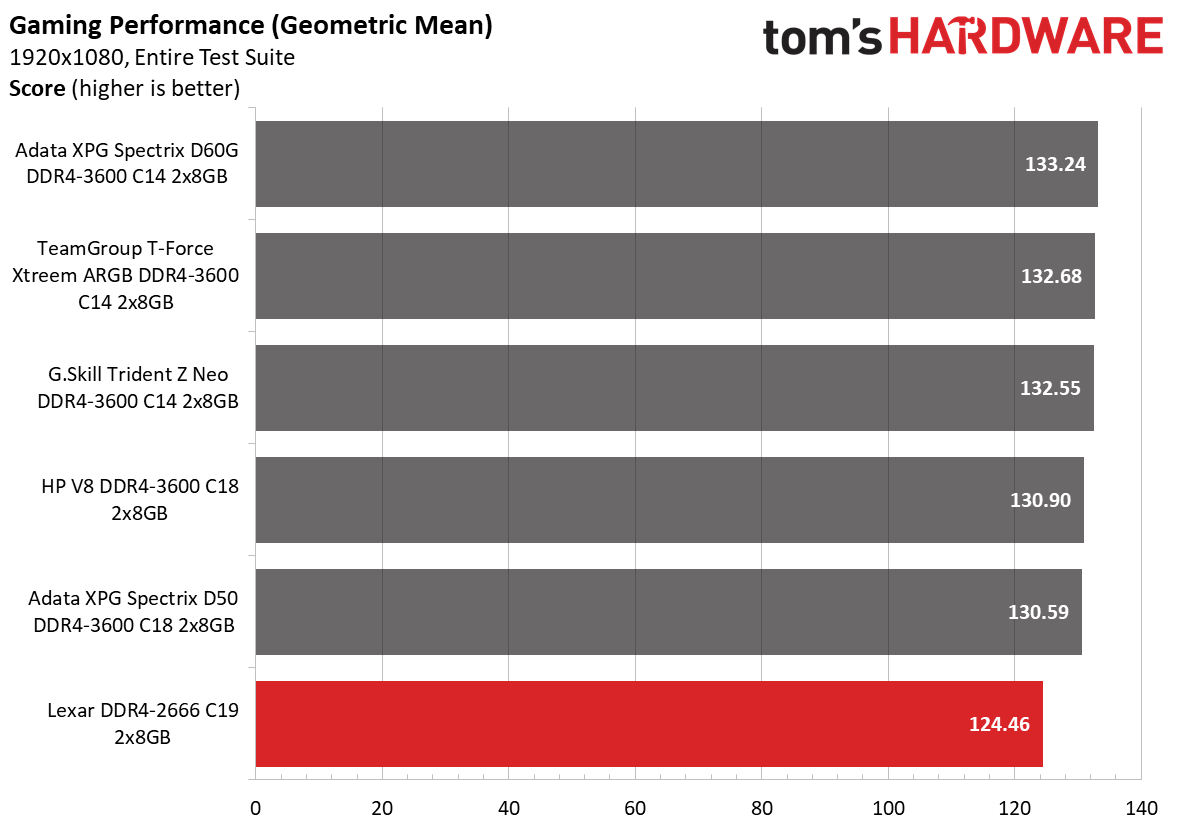
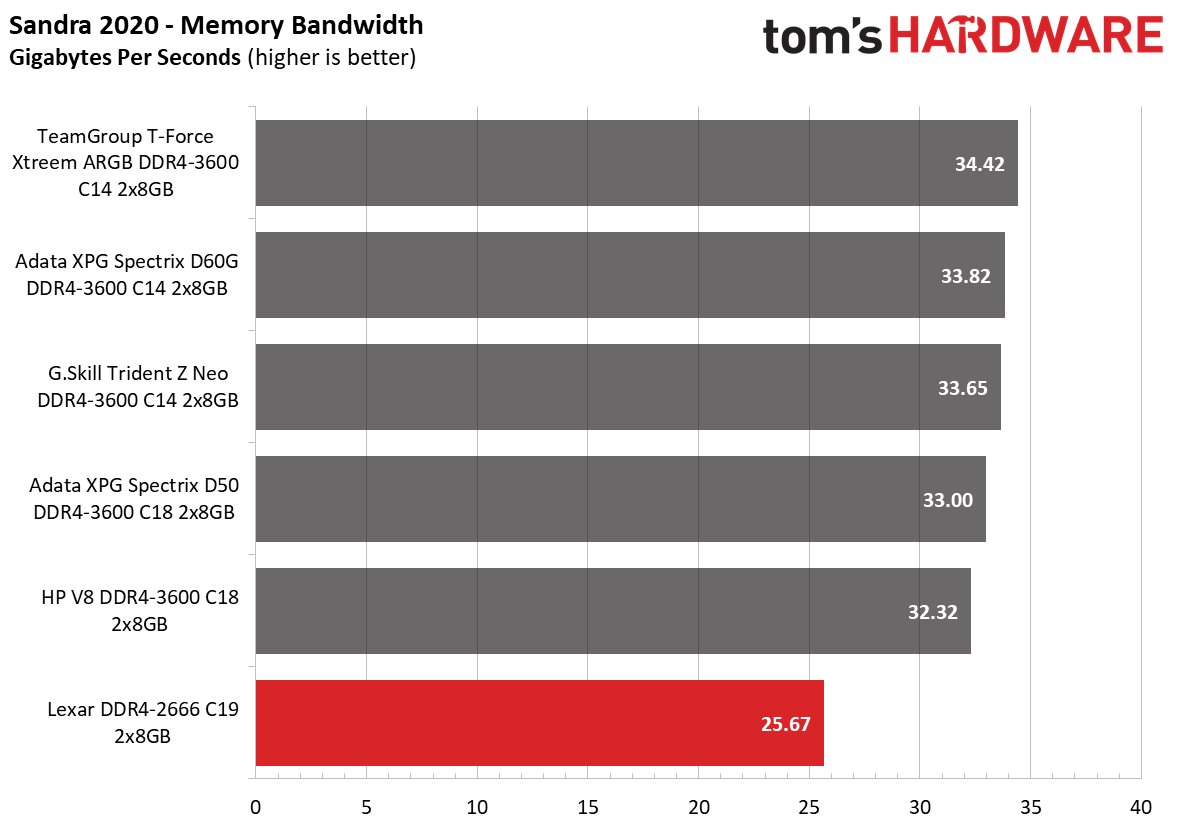

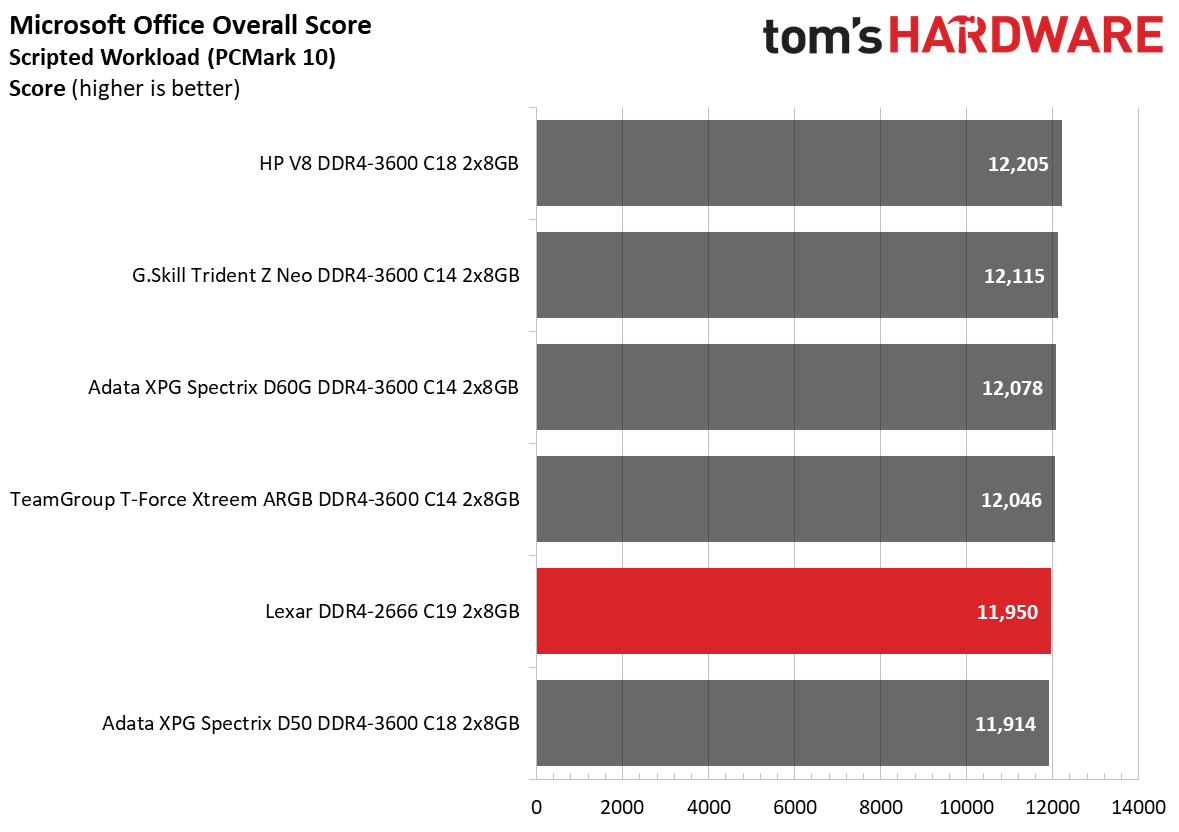
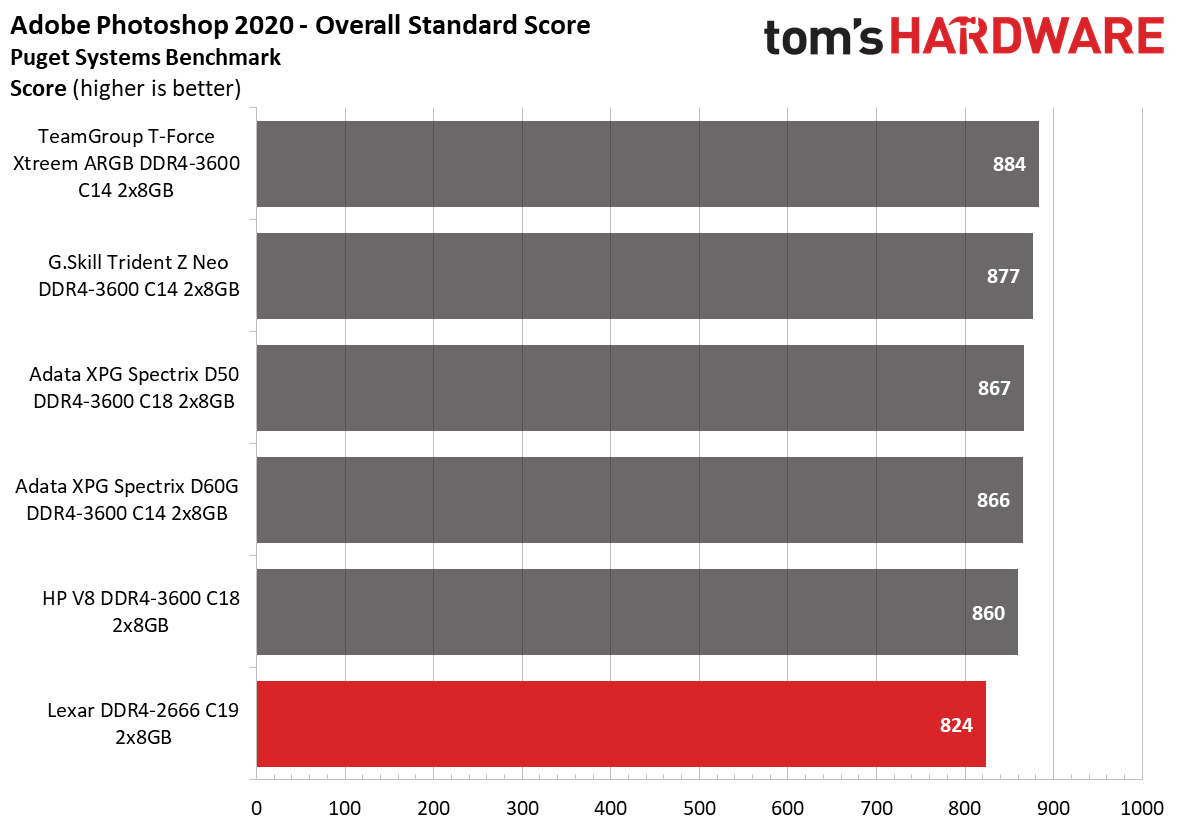

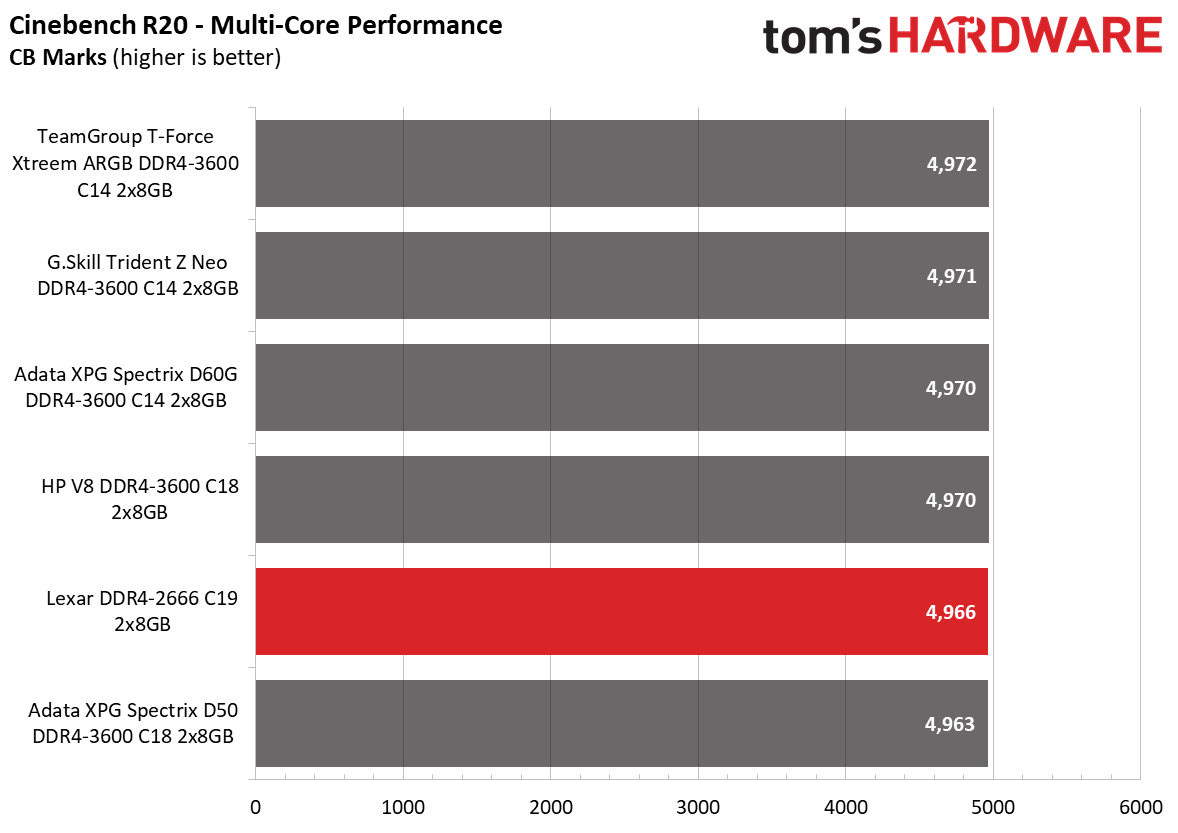
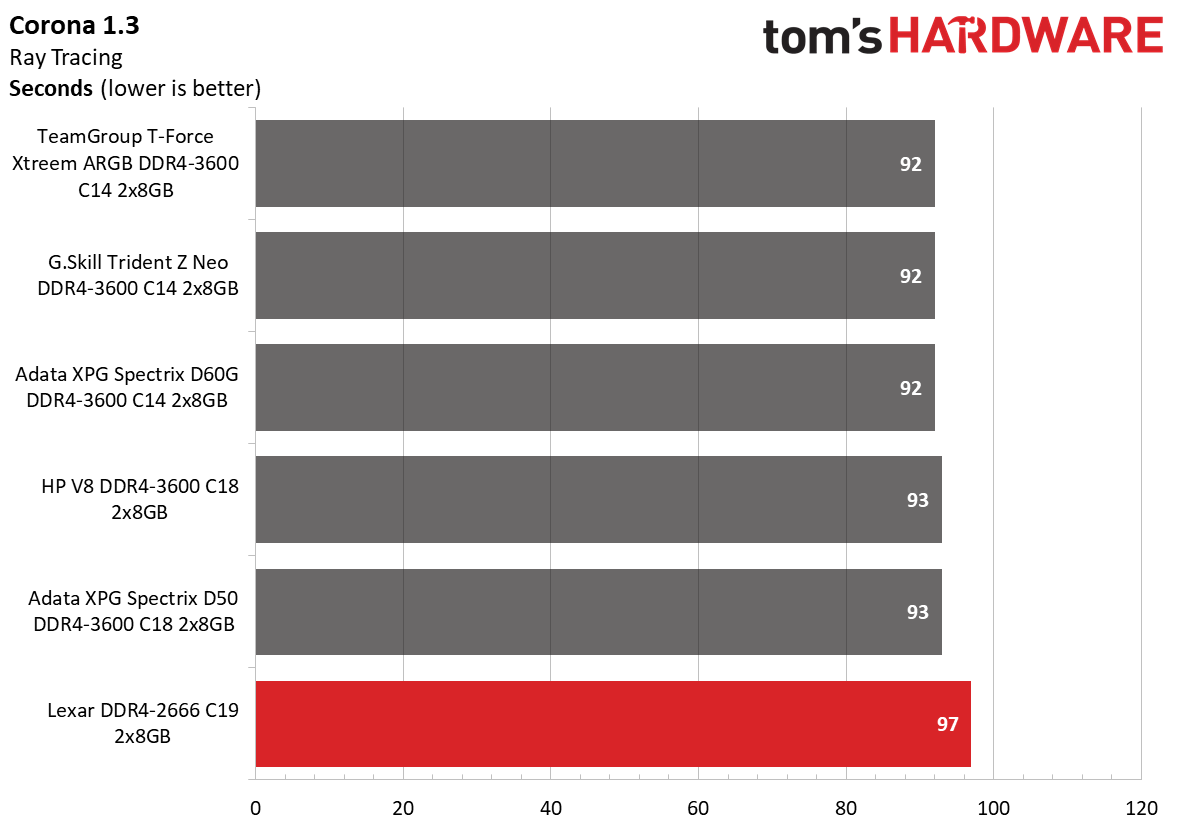
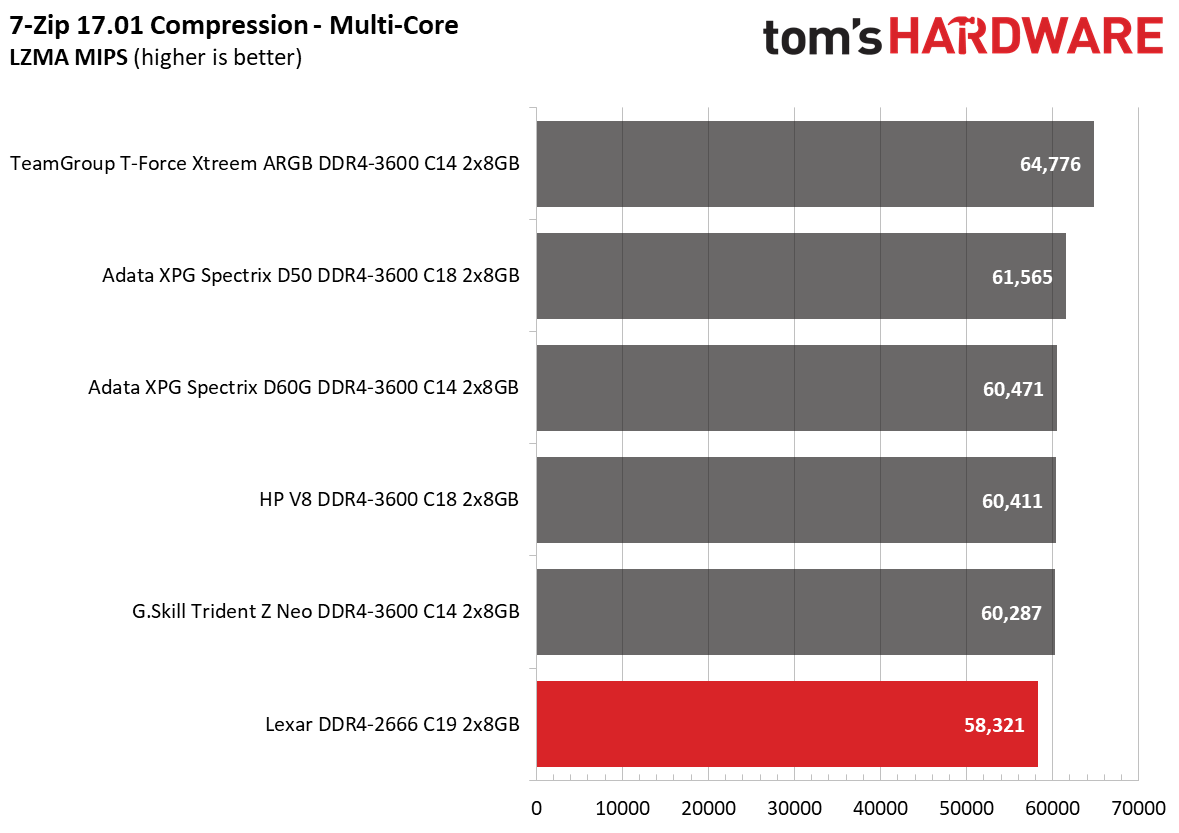
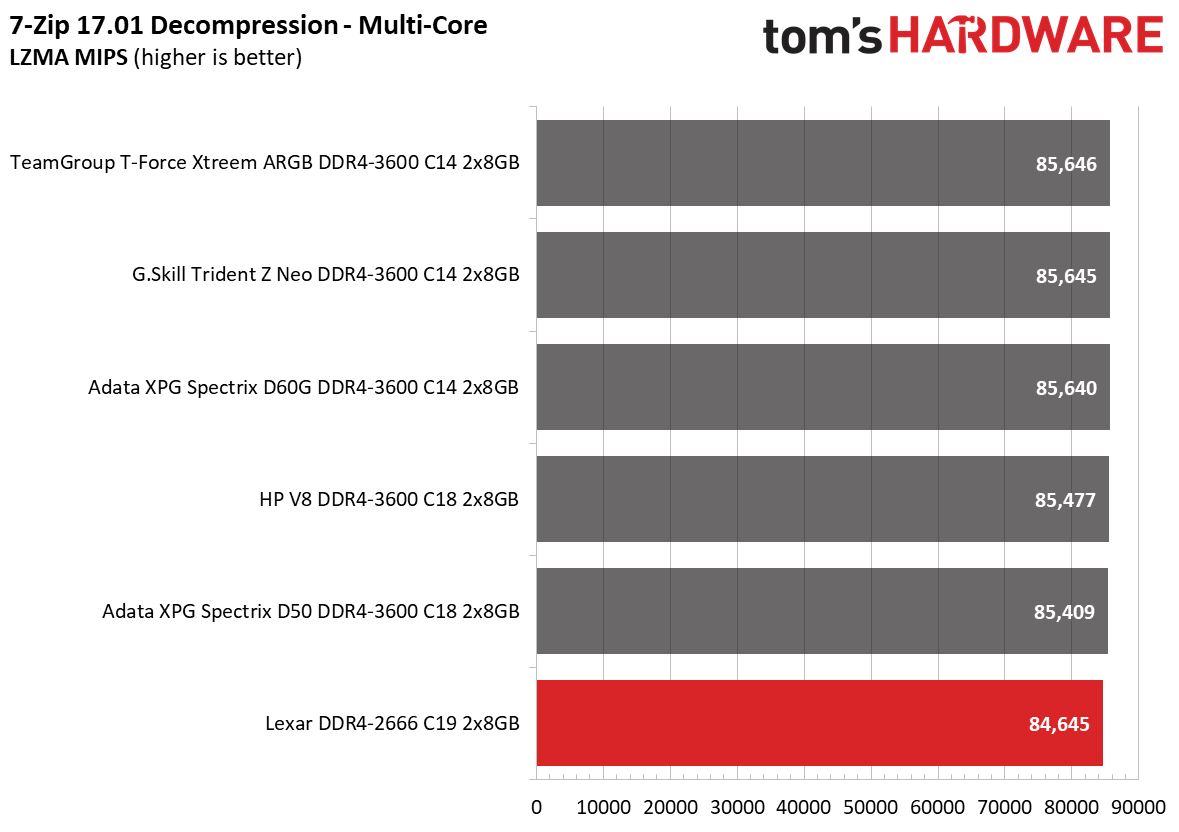
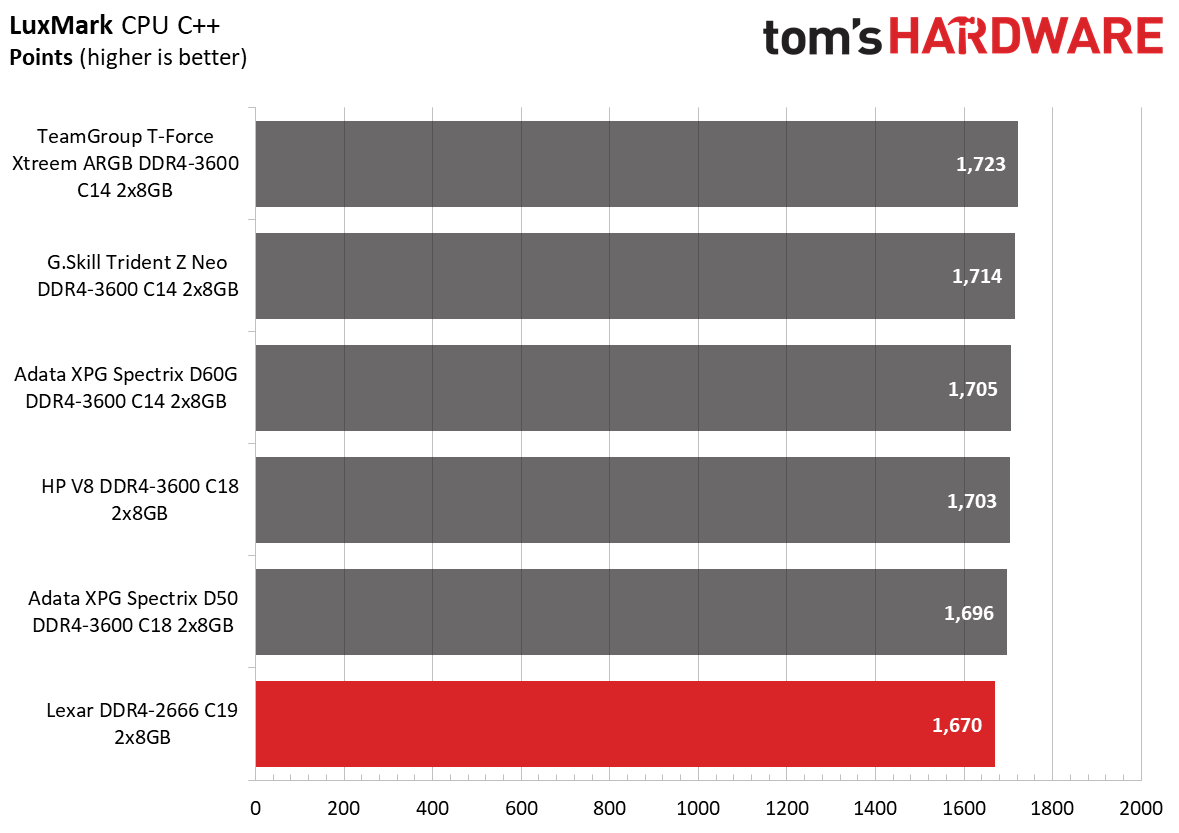
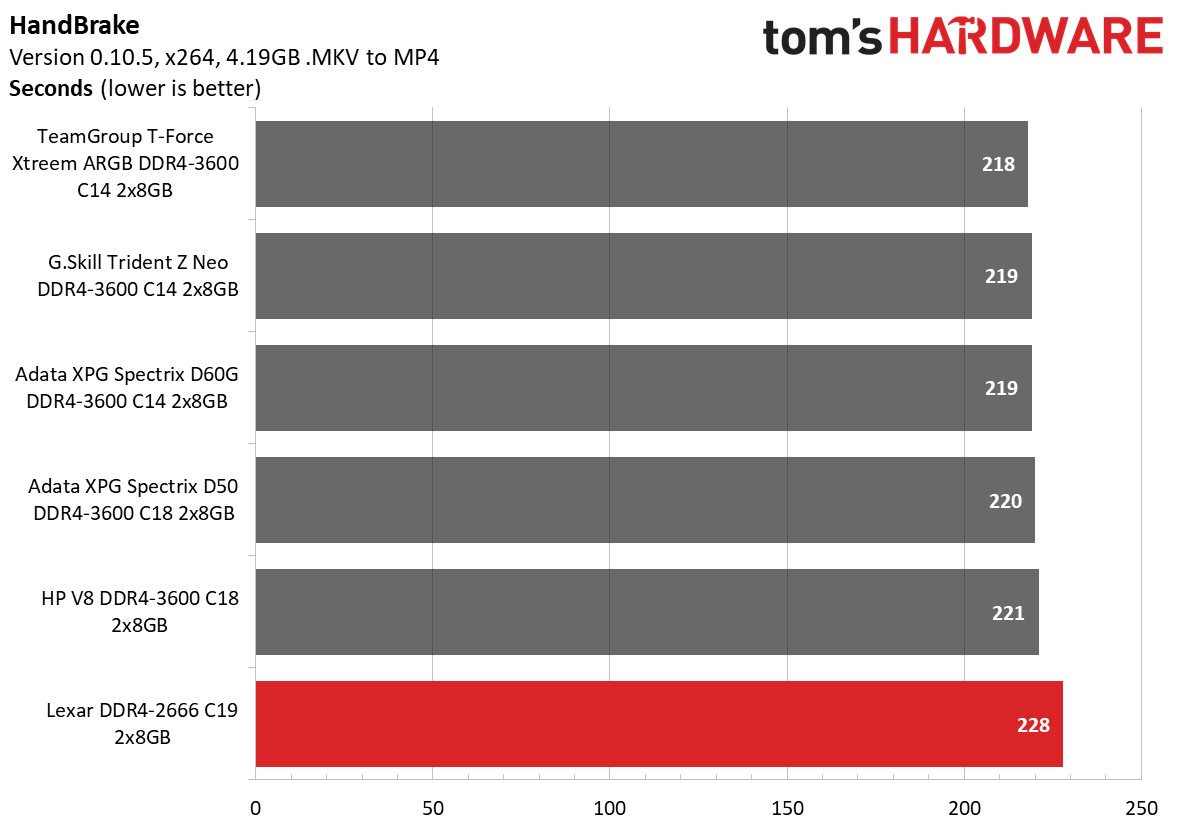
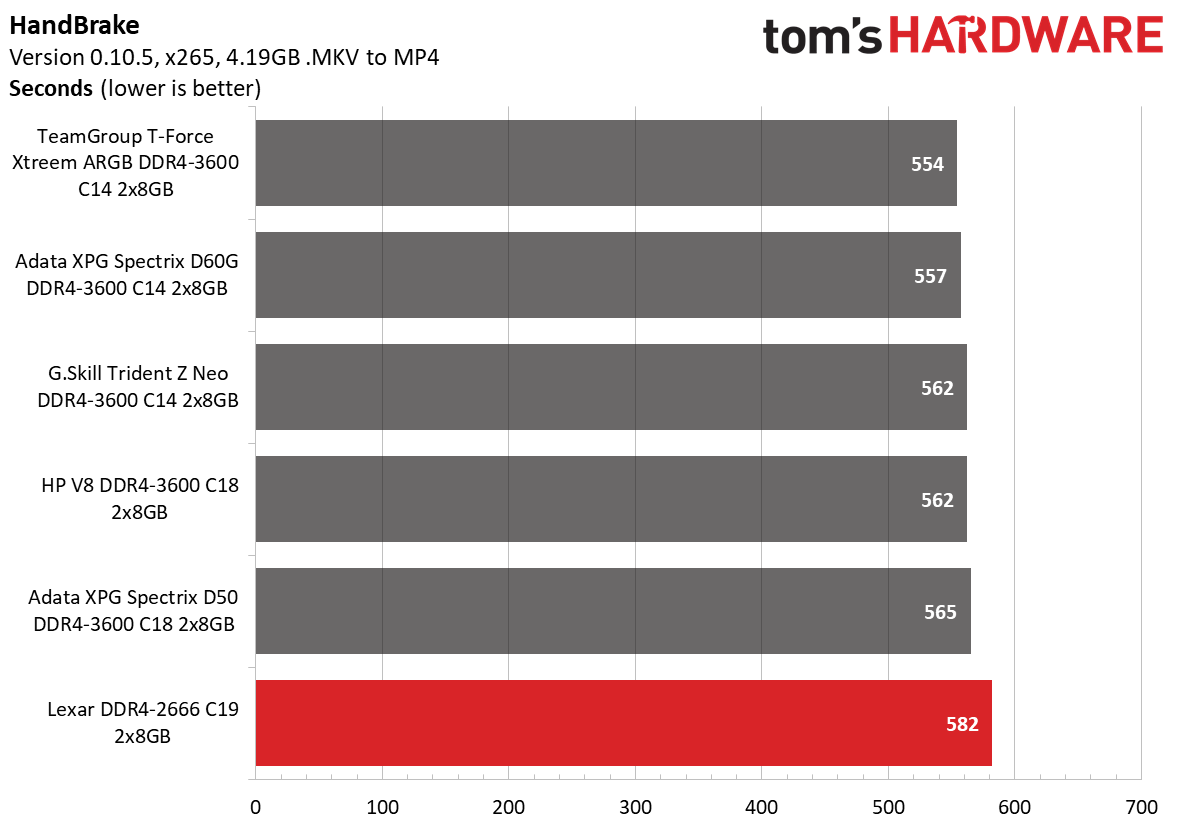
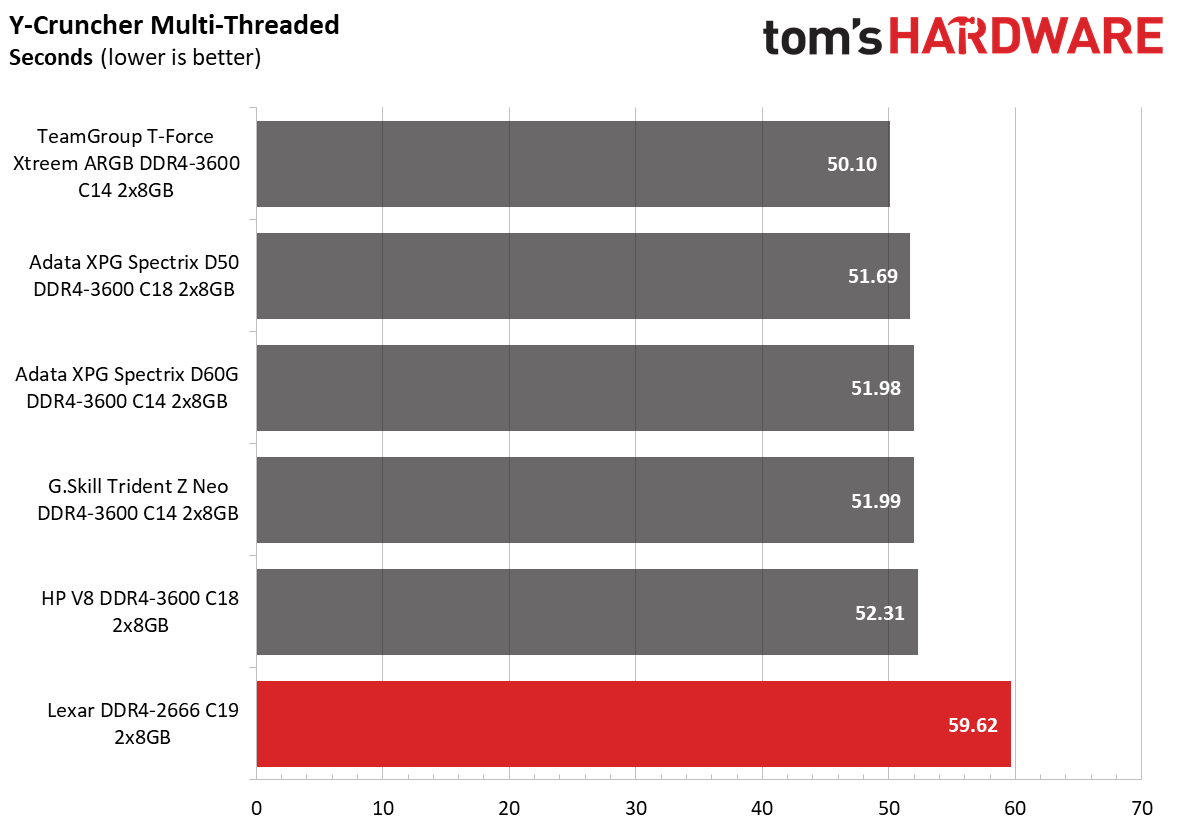

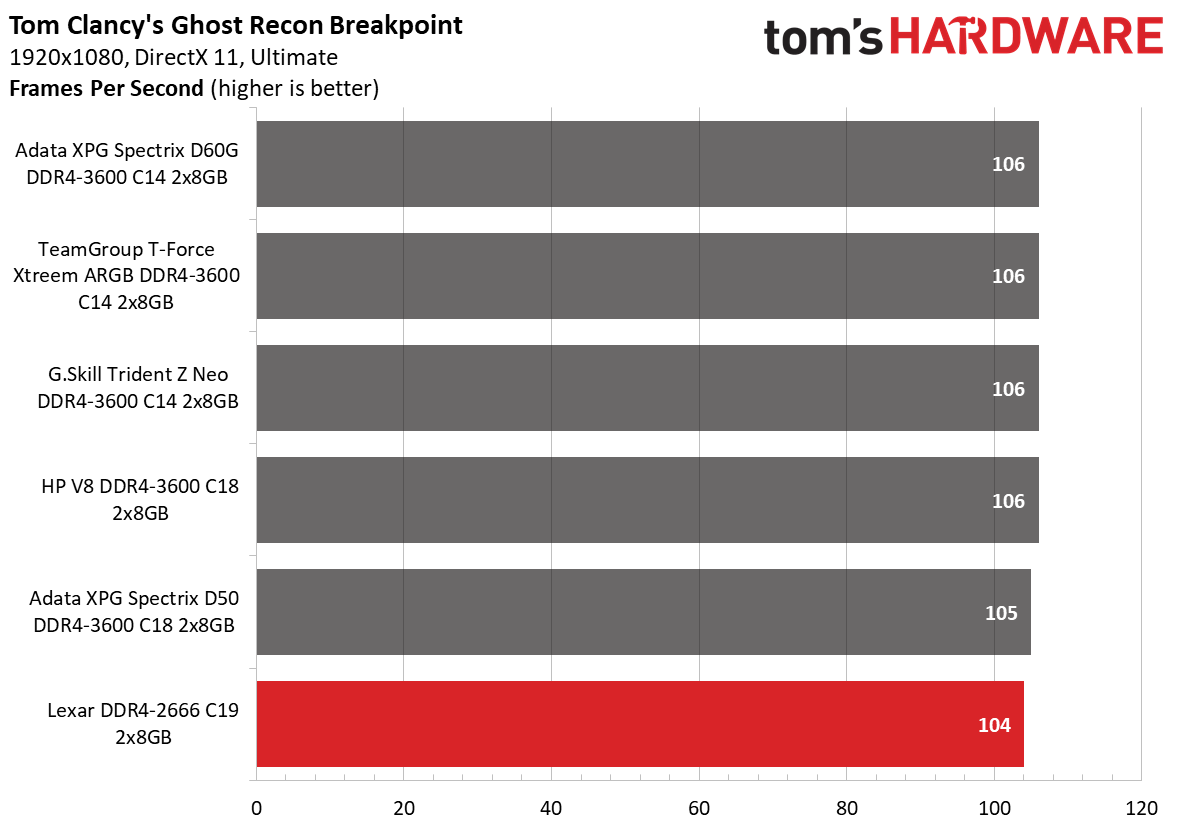

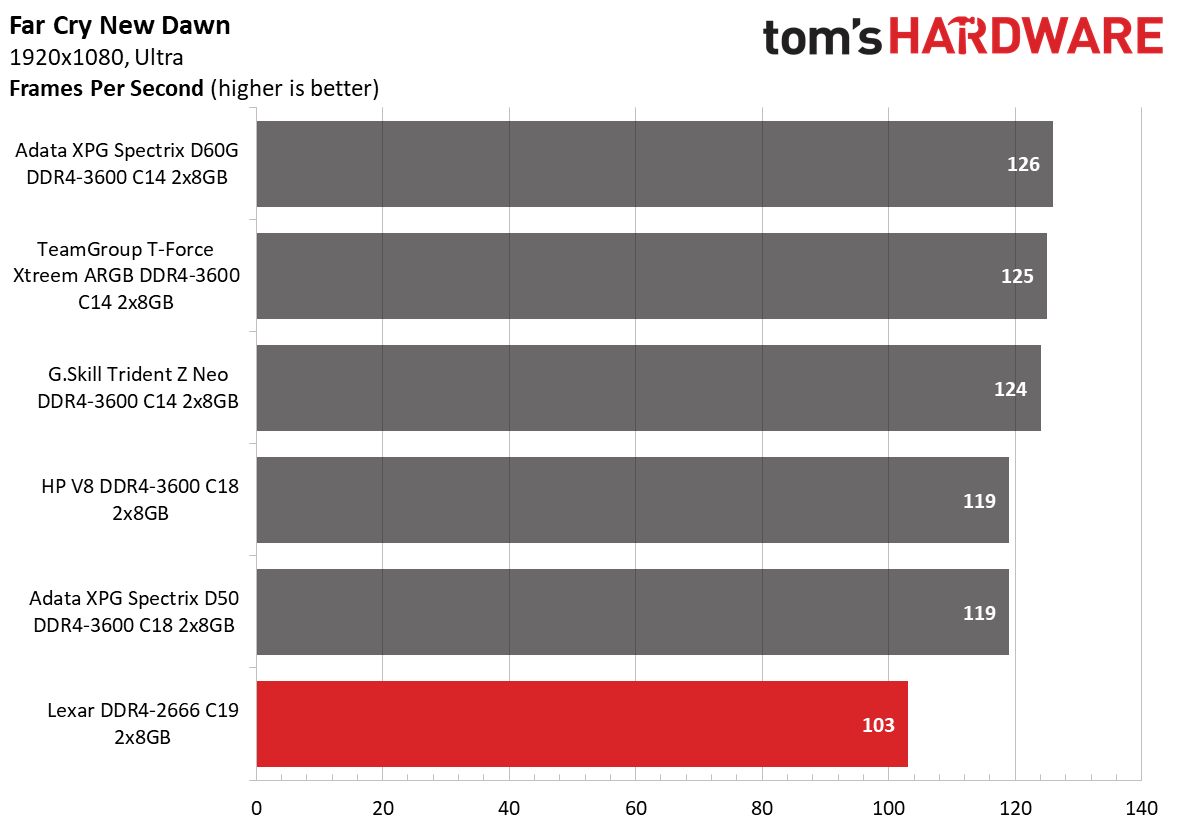
Lexar's DDR4 memory kit ended up at the bottom of the RAM benchmarks. Overall, there was a separation of 5% and 7% between it and the leader on the performance and gaming charts, respectively.
Get Tom's Hardware's best news and in-depth reviews, straight to your inbox.
AMD Performance
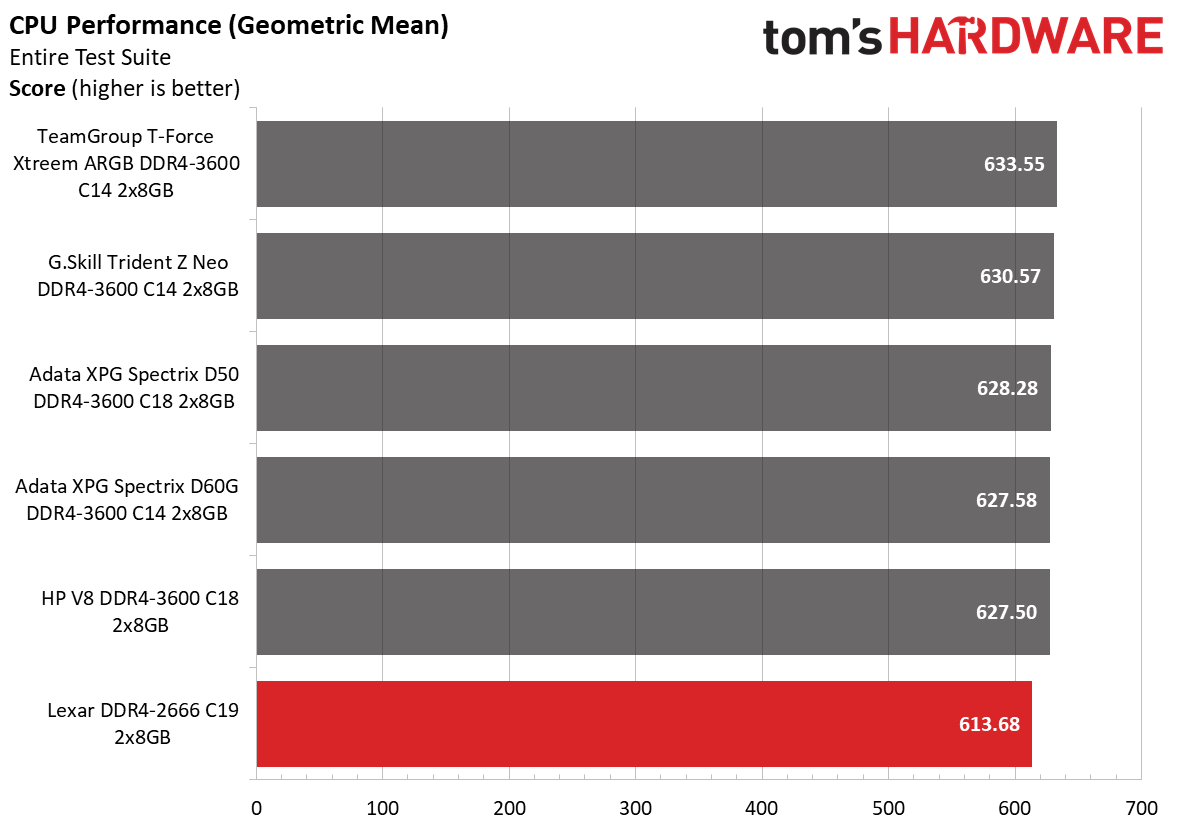


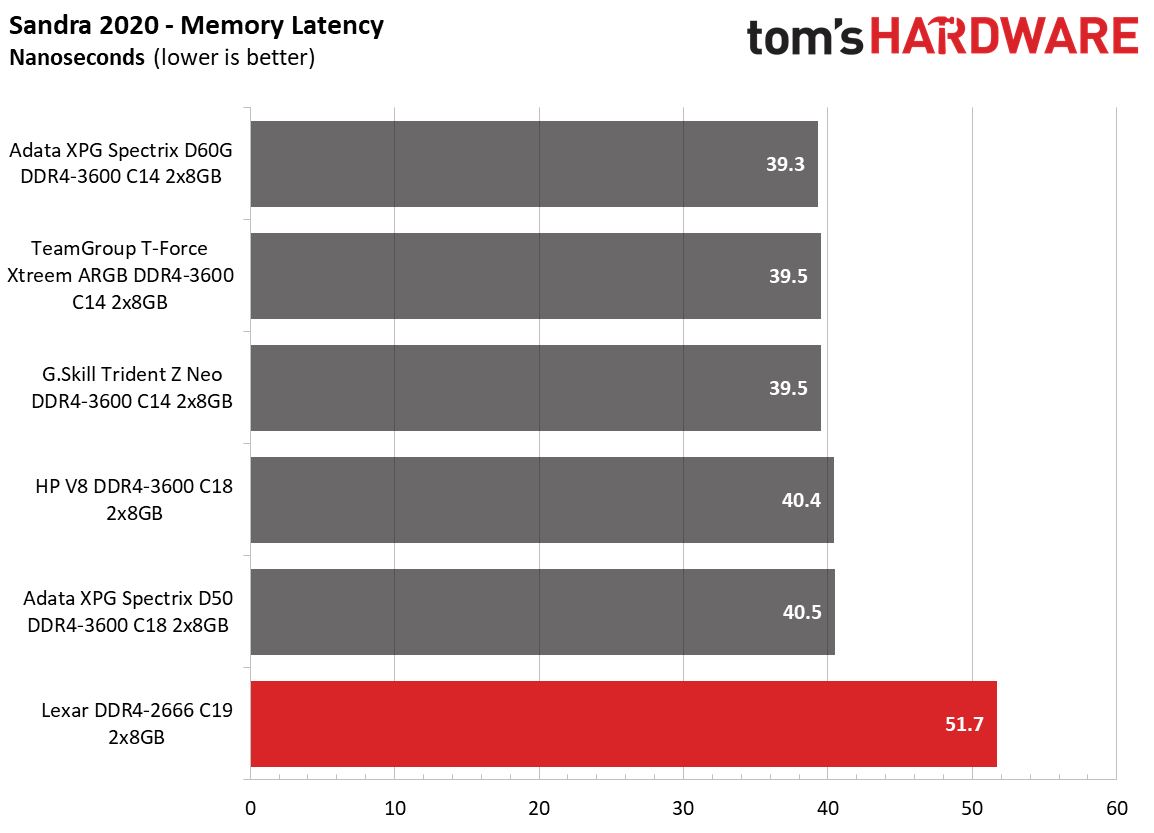

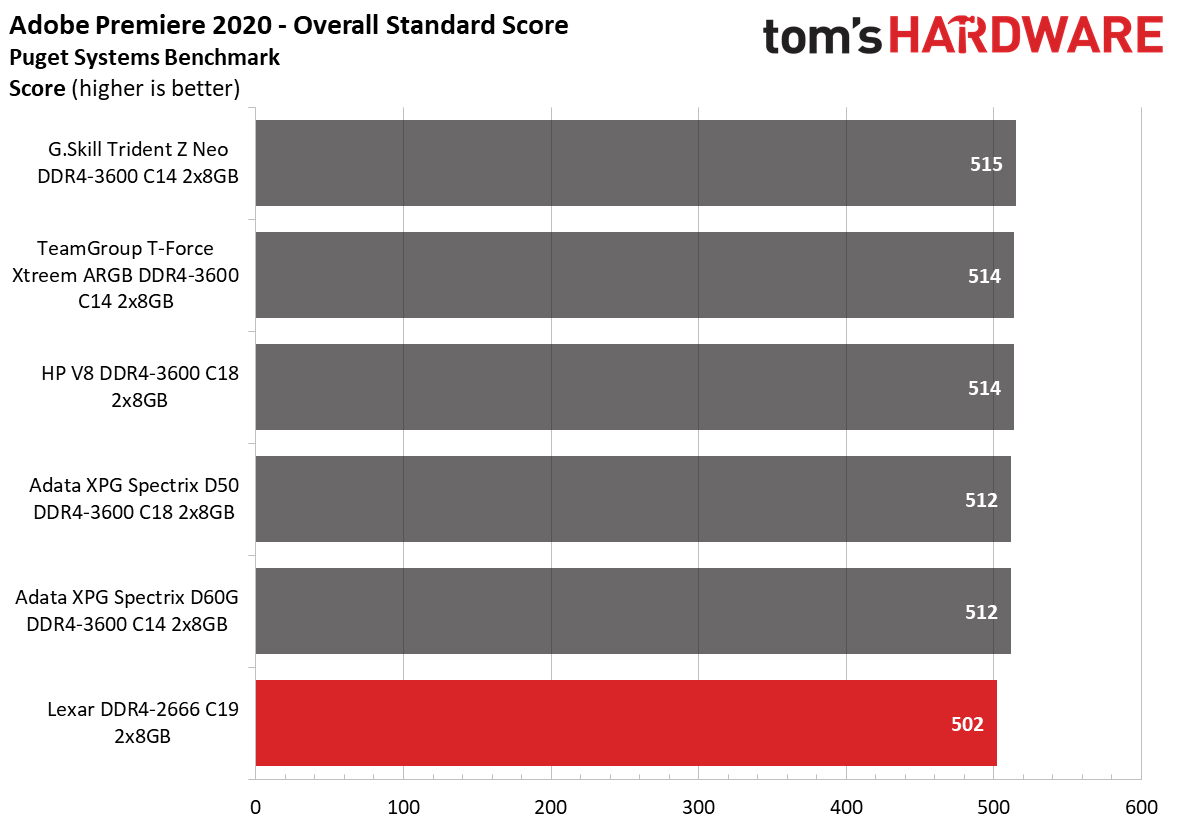


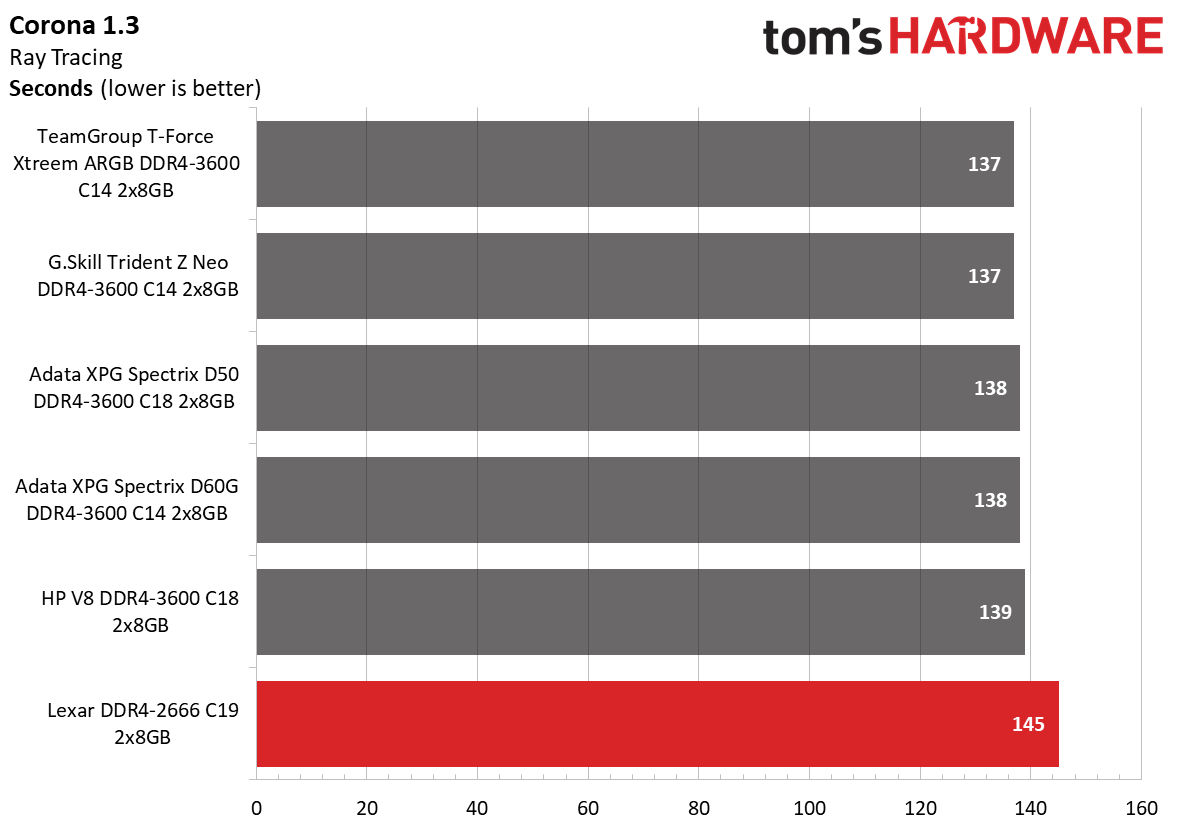
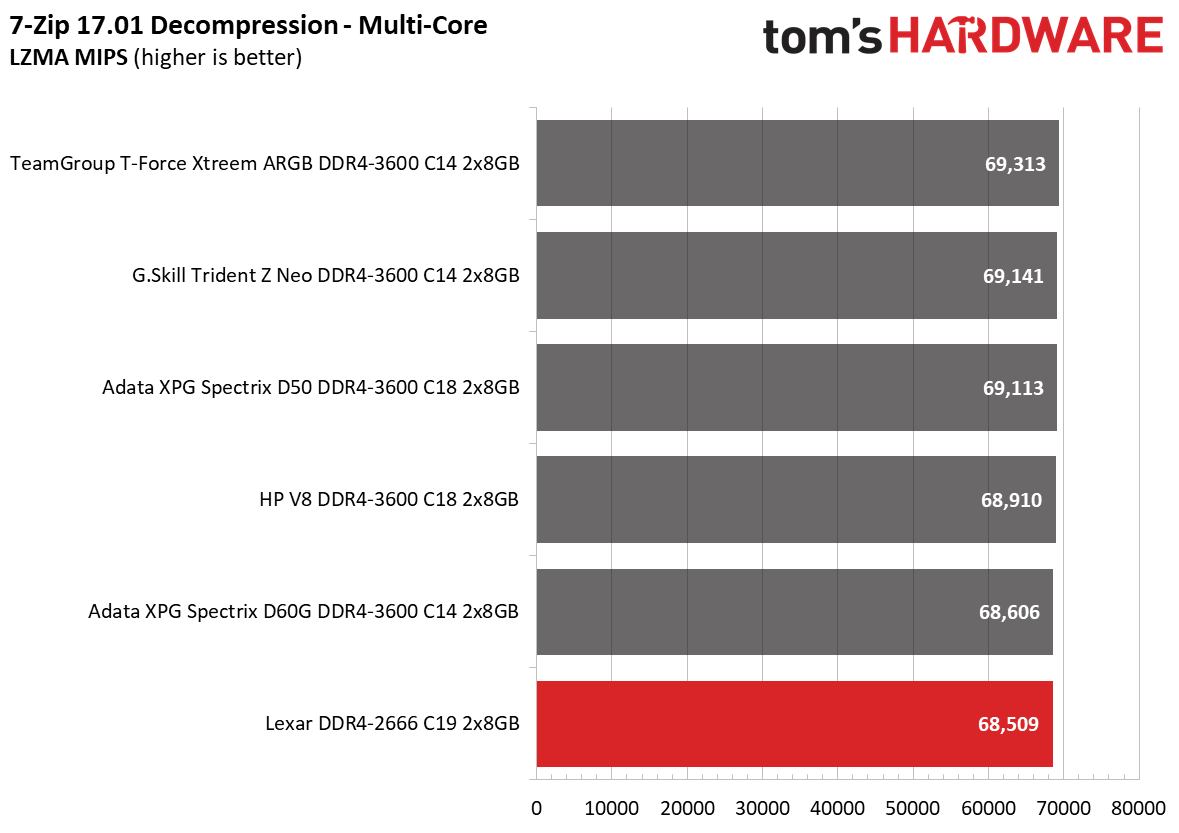
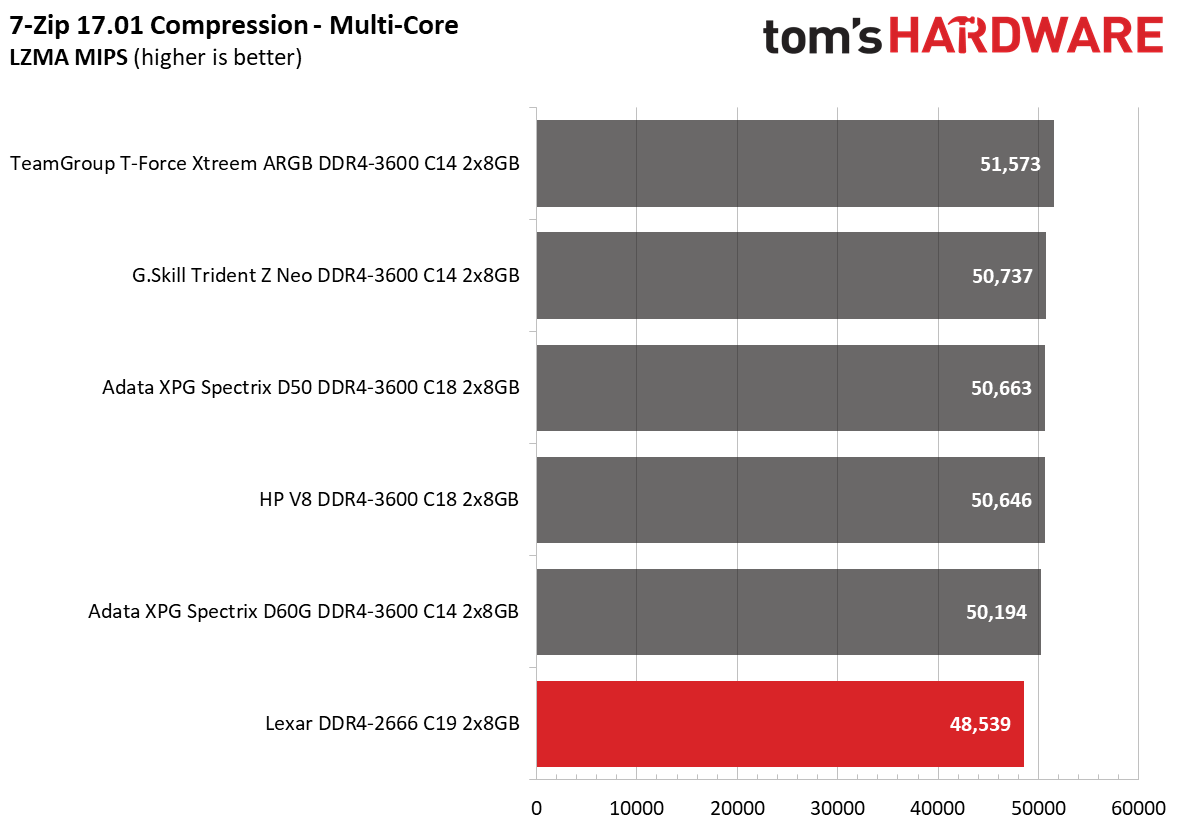
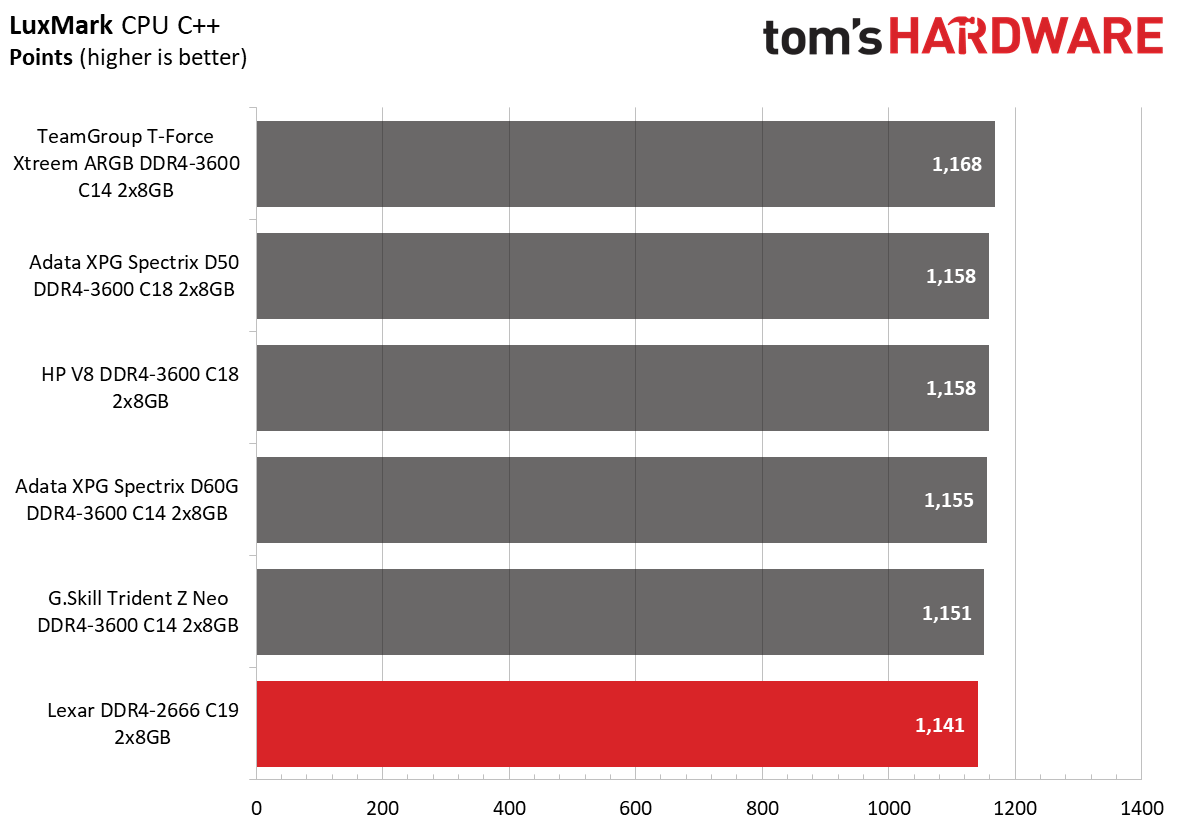
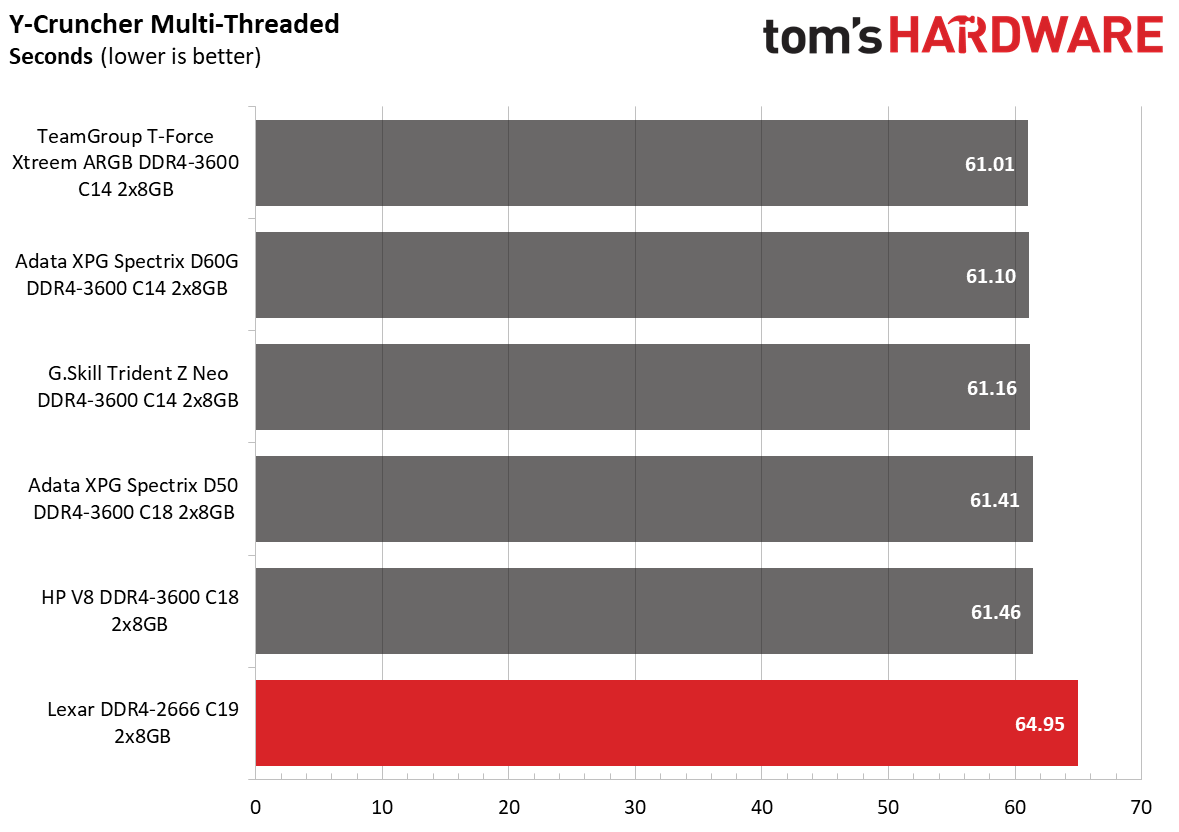


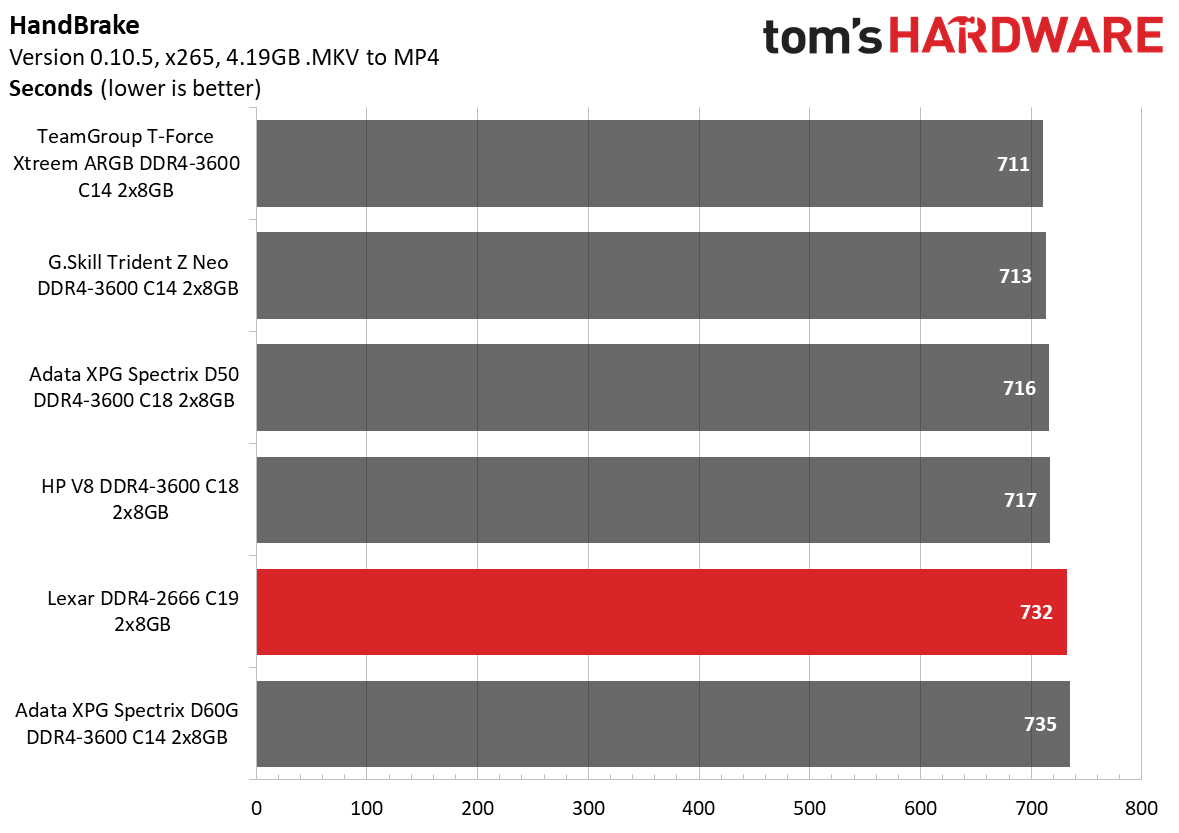


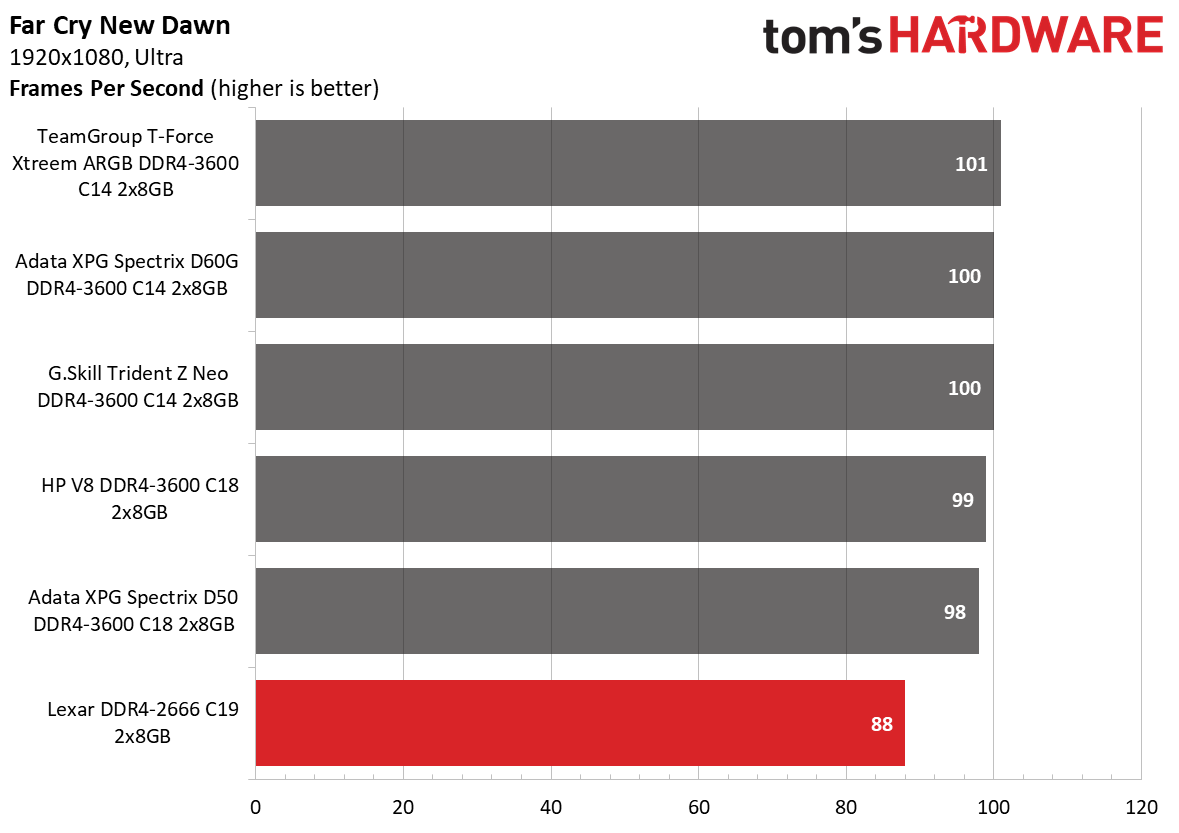
The memory kit performed a bit better on the AMD platform, but its position in the chart remains unaffected. The margins between Lexar's memory kit and the fastest memory kit were 3% on the application performance chart, and 6% on the gaming chart.
Overclocking and Latency Tuning
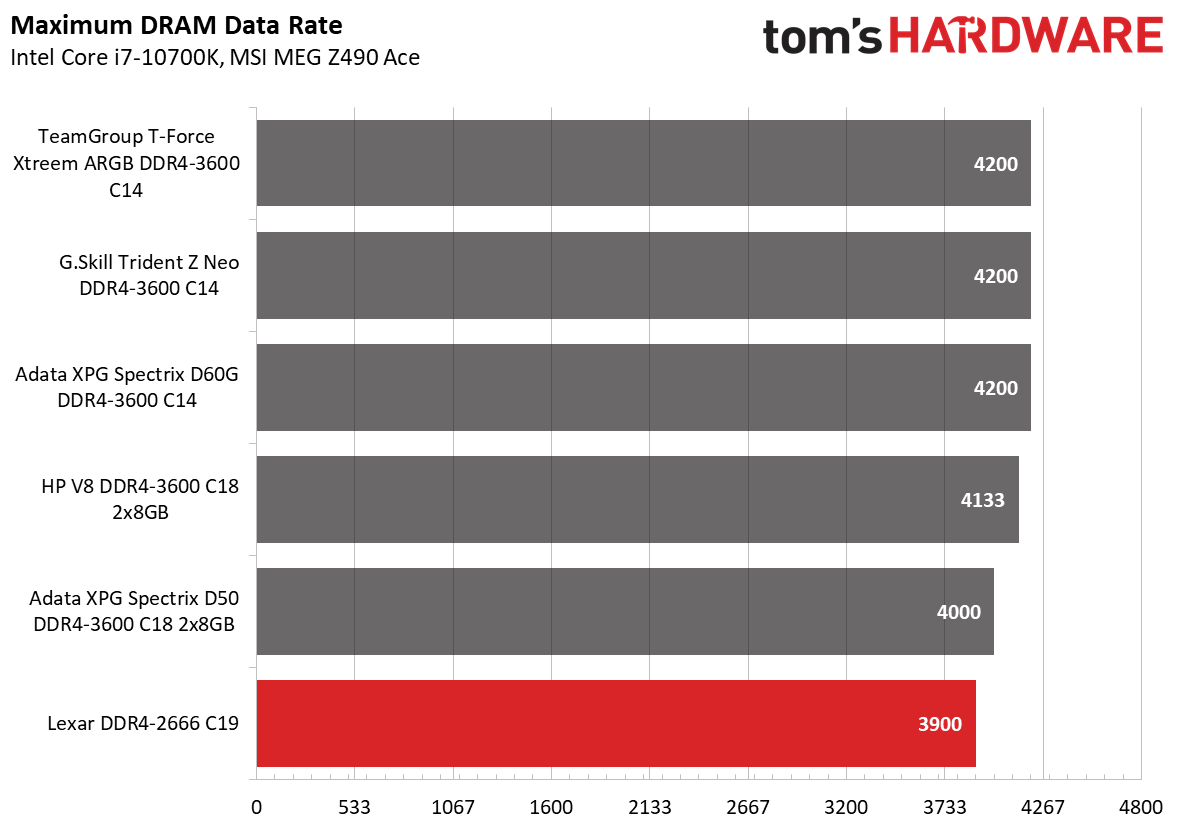
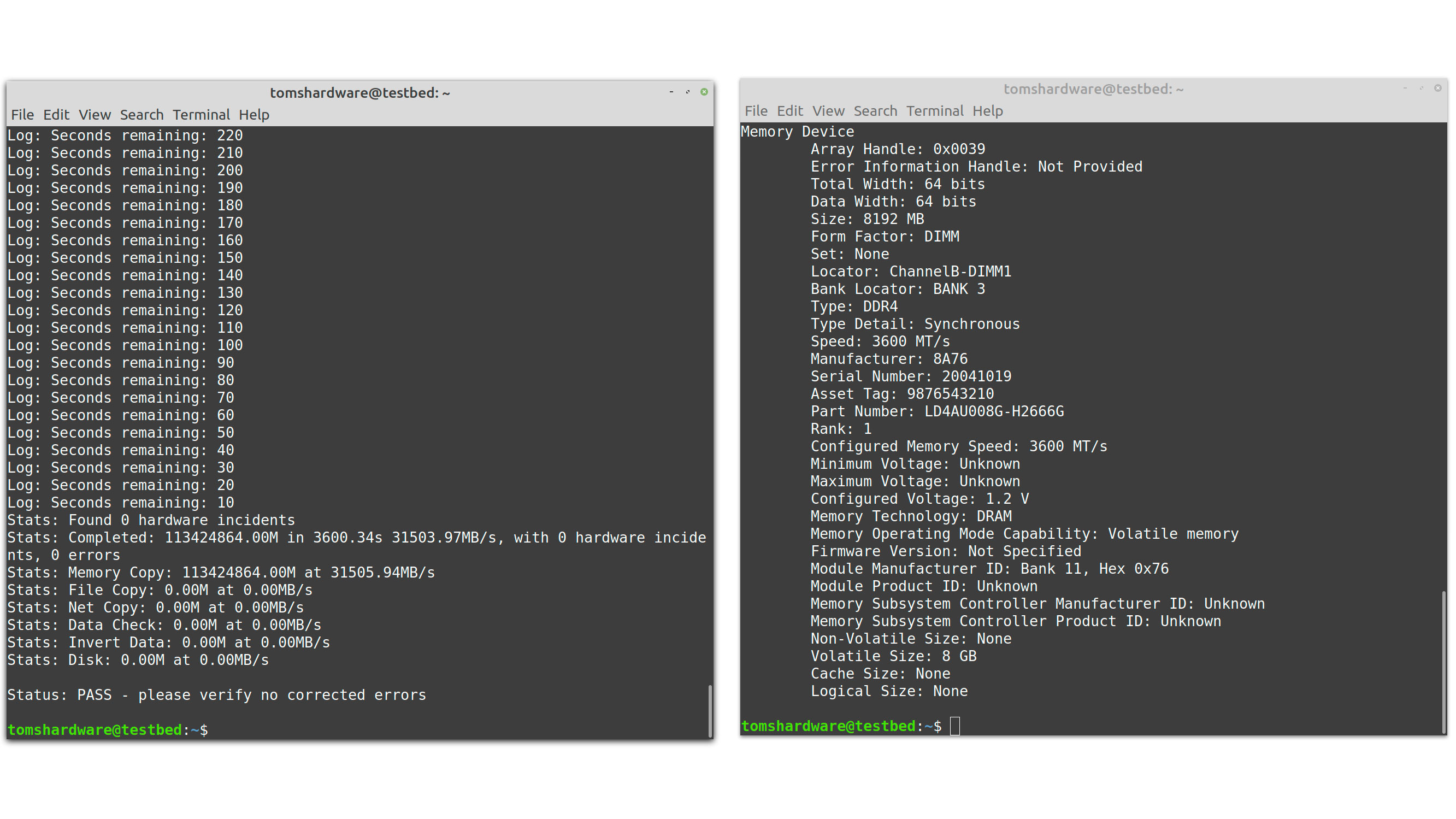
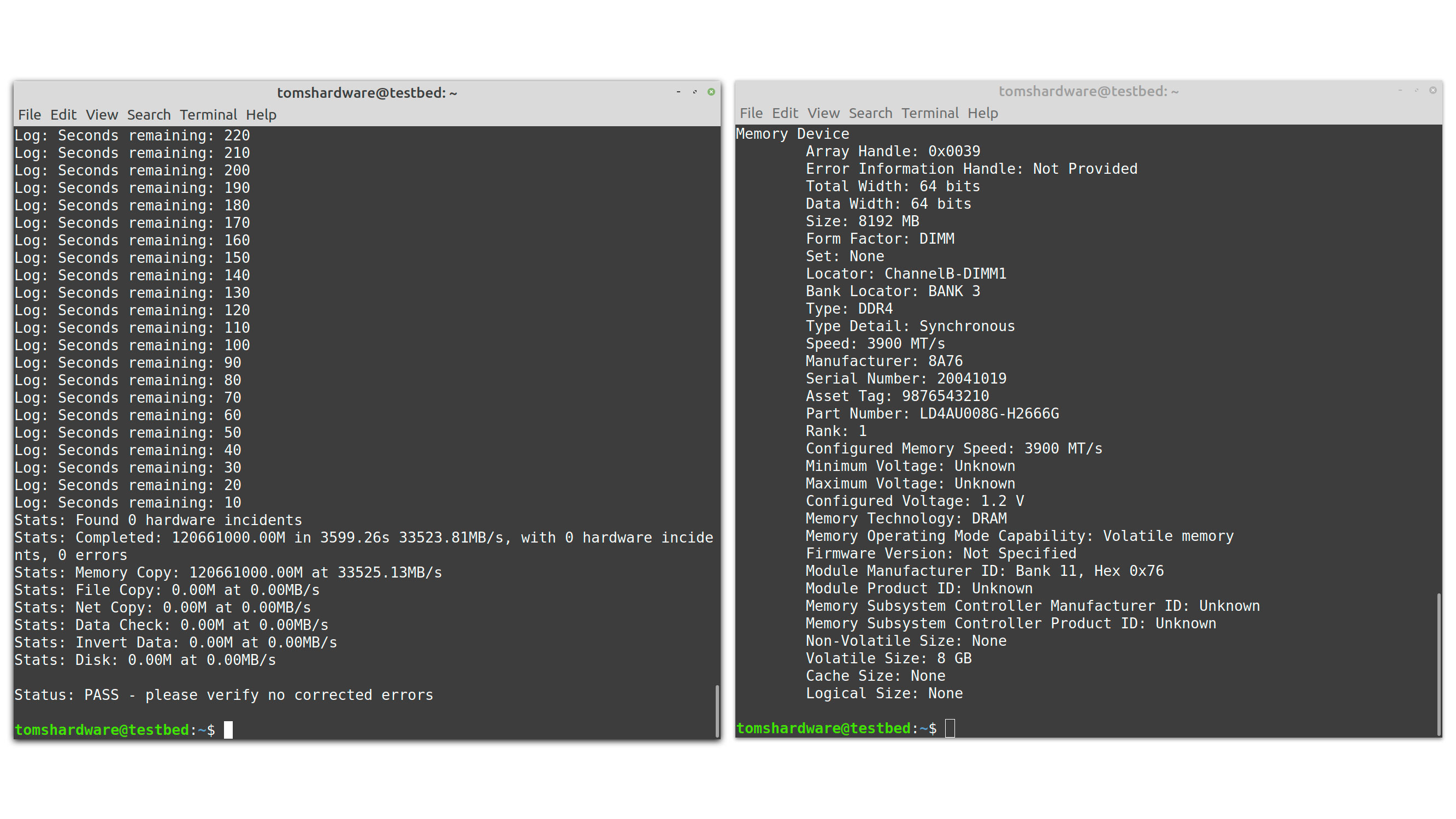
The Lexar DDR4-3600 C19 memory kit ended up with at DDR4-3900 at 1.45V. Sadly, there wasn't much room to tweak the timings. We settled at 17-22-22-42 to achieve stability for a DDR4-3900 data transfer rate.
Lowest Stable Timings
| Memory Kit | DDR4-3600 (1.45V) | DDR4-3900 (1.45V) | DDR4-4000 (1.45V) | DDR4-4133 (1.45V) | DDR4-4200 (1.45V) |
|---|---|---|---|---|---|
| TeamGroup T-Force Xtreem ARGB DDR4-3600 C14 | 13-14-14-35 (2T) | N/A | N/A | N/A | 19-19-19-39 (2T) |
| G.Skill Trident Z Neo DDR4-3600 C14 | 13-16-16-36 (2T) | N/A | N/A | N/A | 19-19-19-39 (2T) |
| Adata XPG Spectrix D60G DDR4-3600 C14 | 13-15-15-35 (2T) | N/A | N/A | N/A | 20-19-19-39 (2T) |
| Adata XPG Spectrix D50 DDR4-3600 C18 | 14-19-19-39 (2T) | N/A | 18-22-22-42 | N/A | N/A |
| HP V8 DDR4-3600 C18 | 14-19-19-39 (2T) | N/A | N/A | 18-22-22-42 (2T) | N/A |
| Lexar DDR4-2666 C19 | 16-21-21-41 (2T) | 17-22-22-42 (2T) | N/A | N/A | N/A |
Instead of optimizing the timings at DDR4-2666, we pushed the Lexar DDR4-2666 memory kit to DDR4-3600 with the lowest possible values. We had to increment the DRAM voltage to 1.45V. The CAS Latency operated fine at 16 clocks, but the tRCD, tRP, and tRAS would not support values below 21-21-41.
Bottom Line
One thing's for certain - Lexar's DDR4-2666 CL19 memory kit won't be winning any performance awards. With that out of the way, the memory kit's only value resides in the headroom that Lexar left for manual overclocking.
But this is the silicon lottery, so there is never a guarantee that you'll be able to get the memory kit up to par with other faster memory kits that are certified to run at their published frequency. Furthermore, you'll have to keep your expectations in check as Lexar's memory modules use Samsung C-die memory dies, which aren't known to allow tight timings like E-die variants.
As mentioned earlier, Lexar presently sells its UDIMM as single modules. Each DDR4-2666 8GB memory module costs $29.99, which means a kit of two will set you back a total of $59.98. Unfortunately, there are more than a handful of faster kits at the sub-$55 price range, including configurations like DDR4-3000 or DDR4-3200 with CL16. At the current pricing, it's hard to pick the Lexar memory kit over other budget offerings. Everyone has to start somewhere, and once Lexar has a feel for what the market wants, we don't doubt that the company will launch improved memory kits further down the road.

Zhiye Liu is a news editor, memory reviewer, and SSD tester at Tom’s Hardware. Although he loves everything that’s hardware, he has a soft spot for CPUs, GPUs, and RAM.
-
derekullo DDR4-2666 C19 is slower than DDR4-3600 C18 and DDR4-3600 C14.Reply
Absolutely mind-blowing article.
